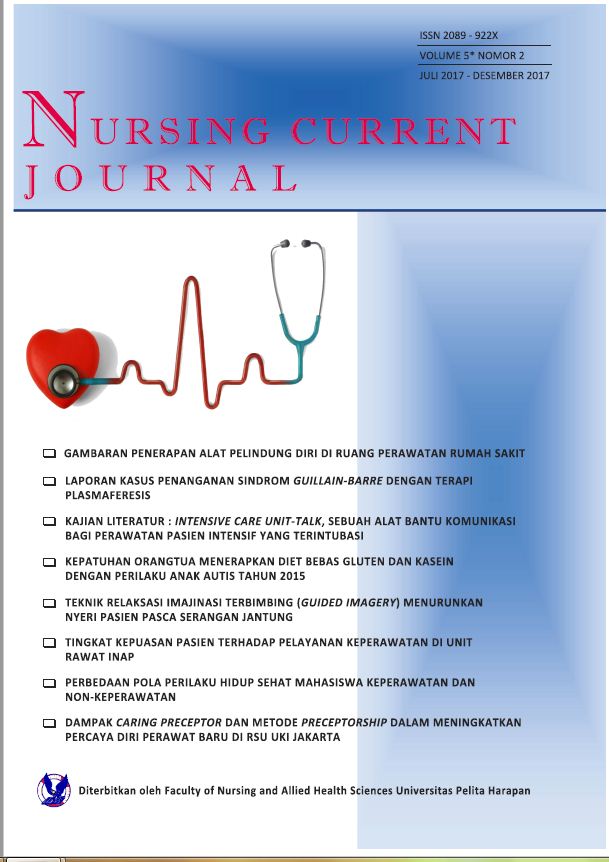GUIDED IMAGERY RELAXATION TECHNIQUES REDUCE PATIENT'S PAIN POST ATTACK HEART [TEKNIK RELAKSASI IMAJINASI TERBIMBING (GUIDED IMAGERY) MENURUNKAN NYERI PASIEN PASCA SERANGAN JANTUNG]
DOI:
https://doi.org/10.19166/nc.v5i2.1703Trefwoorden:
Guided Imagery, Heart Attack, PainSamenvatting
Heart attack or commonly referred to as acute myocardial infarction (AMI) is a life-threatening condition that is marked by the formation of local necrotic area within the myocardium. The usual condition felt by the patient after heart attack is the pain in the chest. Pain is a sensation of individual discomfort felt by the patient. If the pain is not solved it will result in an uncomfortable to the patient either physically or psychologically. One of the interventions that can be used to reduce pain is a guided imagery relaxation technique (Guided Imagery). The purpose of this study was to determine the effect of guided imagery relaxation techniques (Guided Imagery) to decrease the patient's pain after a heart attack at the Flamboyan Lounge Arifin Achmad Hospital in Riau province. The samples in this study were patients with AMI medical diagnoses who experienced moderate pain. The type of this research is quantitative design that is used is quasi experiment "pretest posttest without control group", before and after given intervention measurement of pain scale. The analysis used is paired sample t test. The result of this research shows that there is influence of Guided Imagery relaxation technique to the patient's pain relief after heart attack p value 0,002 (p value <α). This study recommends to develop and carry out research on factors that affect pain in AMI patients
BAHASA INDONESIA ABSTRAK Serangan jantung atau yang biasa disebut juga dengan Infark Miokard Akut (IMA) adalah kondisi yang mengancam jiwa pasien yang di tandai dengan pembentukan area nekrotik lokal di dalam miokardium. Kondisi yang biasa di rasakan oleh pasien pasca serangan jantung yaitu rasa nyeri di bagian dada. Nyeri merupakan respon ketidaknyamanan yang dirasakan oleh individu. Apabila nyeri tidak di atasi maka akan menimbulkan dampak yang tidak nyaman terhadap pasien baik secara fisik ataupun psikologis. Salah satu intervensi yang dapat digunakan untuk mengurangi nyeri adalah teknik relaksasi imajinasi terbimbing. Penelitian ini bertujuan untuk mengetahui pengaruh teknik relaksasi imajinasi terbimbing terhadap penurunan nyeri pasien pasca serangan jantung di Ruang Flamboyan RSUD Arifin Achmad Provinsi Riau. Sampel pada penelitian ini adalah pasien dengan diagnosa medis IMA yang mengalami nyeri sedang. Jenis penelitian ini adalah adalah kuantitatif desain yang di gunakan adalah quasi experimen “pretest posttest without control group”, sebelum dan setelah diberikan intervensi dilakukan pengukuran skala nyeri. Analisa yang di gunakan
adalah uji paired sample t test. Hasil penelitian ini menunjukan ada pengaruh teknik relaksasi imajinasi terbimbing (Guided Imagery) terhadap penurunan nyeri pasien pasca serangan jantung p value 0,002 (p value< α). Penelitian ini merekomendasikan untuk mengembangkan dan melaksanakan penelitian faktor-faktor yang menpengaruhi nyeri pada pasien IMA.
Referenties
Aatmadev, R. (1970, January 1). Jantung. JANTUNG. https://seputar-infokesehatan.blogspot.com/2011/07/percobaan.html
Agustini. (2013). Nyeri serangan jantung. Fakultas Ilmu Keperawatan Universitas Padjajaran. http://pmb.psikpadjajaran.ac.id
Aprianto, D., Kristyawati, S. P., & Purnomo, E. C. (2013). Efektivitas teknik relaksasi imajinasi terbimbing dan nafas dalam terhadap kecemasan pada pasien preoperasi. http://pmb.stikestelogorejo.ac.id/ejournal/index.php/ilmukeperawatan/article/view 166
Asmadi. (2008). Konsep dan aplikasi kebutuhan dasar klien. Salemba Medika.
Baransyah, L. (2014). Faktor-faktor yang berpengaruh terhadap kejadian gagal jantung pada pasien infark miokard akut. http//e-journal.com/faktorfaktor.IMA.2014/10
Kementerian Kesehatan Republik Indonesia. (n.d.). Beranda. https://www.kemkes.go.id/article/view/201410080002/lingkungan-sehat-jantung-sehat.html
Black, J. M., & Hawks, J. H. (2009). Keperawatan medikal bedah (8th ed.). Salemba Medika.
Cipto, S. (2015). Identifikasi faktor usia, jenis kelamin dengan luas infark miokard pada penyekit jantung koroner. http.//www.ejournal.com/2015/14/identifikasi/IMA.html
Didi, K., Ibrahim, K., & Putri, A. P. (2015). Pengalaman pasien pertama mengalami serangan jantung pertama kali yang dirawat di ruang ICU. http://jkp.fkep.unpad.ac.id/index.php/jkp/article/view/102Gobel, F. A., & Mahkota, R. (2006). Faktor-Faktor Yang Mempengaruhi Kematian Pasien Penyakit Jantung Koroner di Pusat Jantung nasional harapan kita tahun 2004. Kesmas: National Public Health Journal, 1(3), 99. https://doi.org/10.21109/kesmas.v1i3.303
Gorman, B. (2010). The power of guided imagery. Mandala.
Guided imagery/guided mental imagery. (2013). Encyclopedia of Pain, 1393-1393. https://doi.org/10.1007/978-3-642-28753-4_200916
Jefri. (2011). Fakor-faktor penyebab kejadian IMA. http://journal.Ima.ac.id/download/455
Kaplan, B. J., & Sadock, V. A. (2010). Sinopsis psikiatri keperawatan klinis. Bina Rupa Ashara Publizer.
Muttaqin, A. (2009). Asuhan keperawatan klien dengan gangguan sistem kardiovaskular dan hematologi. Salemba Medika.
Potter, P. A., & Perry, A. G. (2009). Buku ajar fundamental keperawatan (7th ed.). EGC.
##submission.downloads##
Gepubliceerd
Citeerhulp
Nummer
Sectie
Licentie
Authors who publish with this journal agree to the following terms:
1) Authors retain copyright and grant the journal right of first publication with the work simultaneously licensed under a Creative Commons Attribution License (CC-BY-SA 4.0) that allows others to share the work with an acknowledgement of the work's authorship and initial publication in this journal.
2) Authors are able to enter into separate, additional contractual arrangements for the non-exclusive distribution of the journal's published version of the work (e.g., post it to an institutional repository or publish it in a book), with an acknowledgement of its initial publication in this journal.
3) Authors are permitted and encouraged to post their work online (e.g., in institutional repositories or on their website). The final published PDF should be used and bibliographic details that credit the publication in this journal should be included.

This work is licensed under a Creative Commons Attribution-ShareAlike 4.0 International License.






